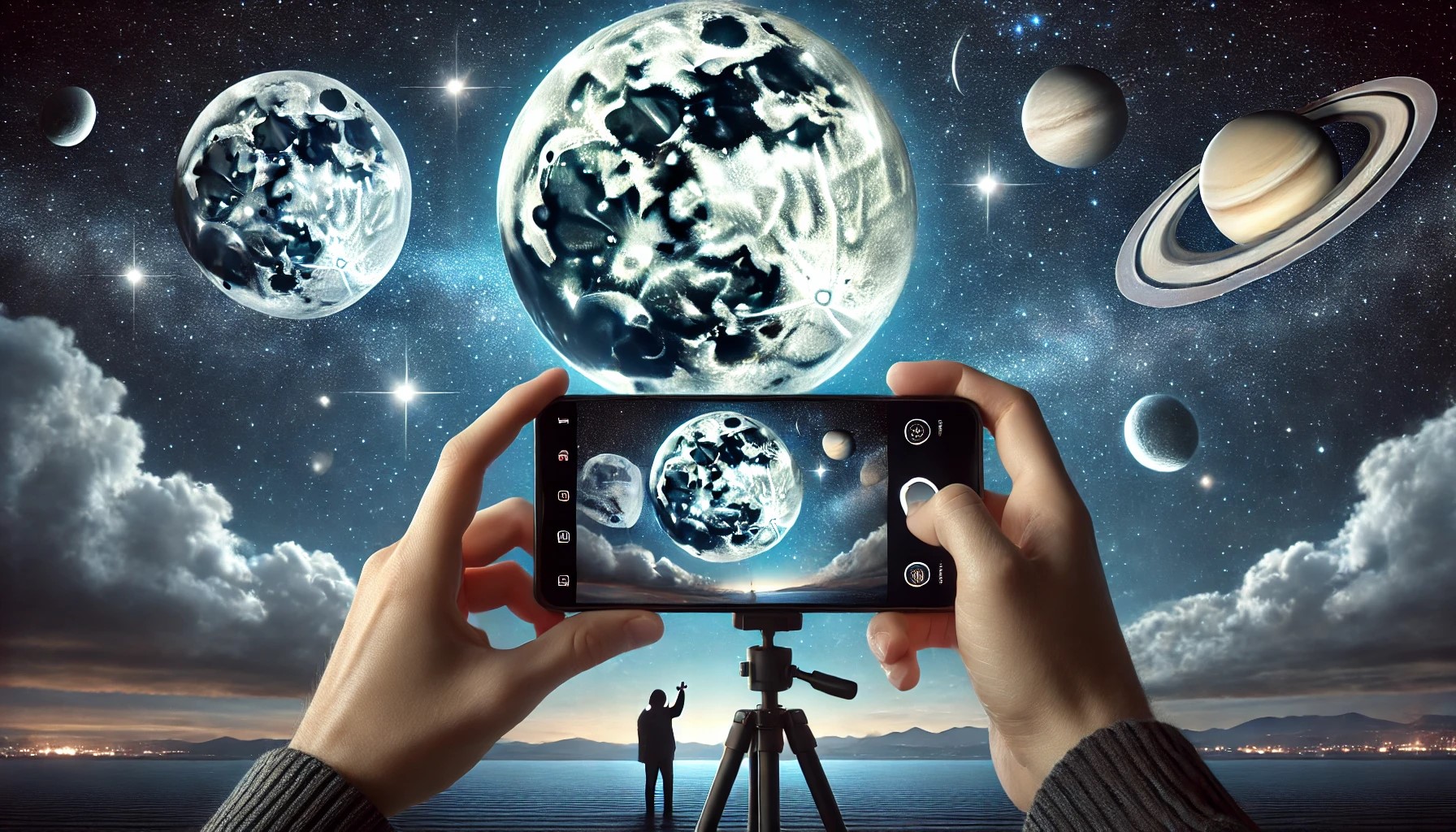Smartphones have advanced to the point where capturing detailed photos of the moon and planets is possible with the right approach. While they lack the powerful lenses of professional cameras, they offer flexibility and ease of use. By adjusting settings, using accessories, and applying a few photography techniques, you can achieve striking results.
1. Choose the Right Conditions
The atmosphere plays a major role in astrophotography. Plan your shoot under favorable conditions for the best results.
- Clear Skies – Avoid nights with heavy clouds, haze, or pollution.
- Low Humidity – Moisture in the air distorts light, reducing clarity.
- Minimal Light Pollution – Move away from city lights or find a higher vantage point.
- Stable Air – Nights when the stars appear steady, rather than twinkling, provide sharper images.
2. Use a Tripod for Stability
A steady phone is necessary for clear shots. Even slight hand movement can blur fine details. A tripod prevents this by keeping your phone still.
- Mini tripods are portable and easy to carry.
- Adjustable phone mounts secure your device in place.
- Remote shutters or timers help avoid shaking when capturing images.
3. Adjust Your Camera Settings
Most default camera apps are optimized for everyday photography rather than celestial objects. Switching to manual or “Pro” mode gives you more control.
- ISO – Lower values (100–400) reduce noise, while higher values (800+) capture more light. Experiment to balance brightness and clarity.
- Shutter Speed – A slower shutter (1/2 to 1 second) allows more light, but too long will cause motion blur.
- Focus – Set to infinity for distant objects. Some apps let you manually adjust focus for precision.
- Exposure – Reduce exposure if the moon appears too bright, revealing more surface detail.
4. Use a Telephoto Lens or Clip-On Zoom
Smartphones have limitations in zooming, often relying on digital zoom, which reduces image quality. A clip-on telephoto lens provides actual optical magnification, improving sharpness.
- 10x–20x zoom lenses bring distant planets and the moon closer.
- Attachable telescope adapters allow your phone to use a telescope’s magnification.
5. Experiment with Night Mode and HDR
Many smartphones feature Night Mode, designed for low-light conditions. It takes multiple shots and combines them for a well-lit result.
- Night Mode works well for bright objects like the moon.
- HDR (High Dynamic Range) enhances contrast and highlights details.
These modes may not work well for planets, as their movement during long exposures can cause blurring.
6. Use Third-Party Apps for More Control
Built-in camera apps have limitations, but third-party apps provide full manual control.
- Camera FV-5 (Android) – Offers DSLR-like settings.
- ProCamera (iOS) – Allows fine-tuned adjustments.
- NightCap Camera (iOS) – Specialized for astrophotography.
These apps give access to long exposure, ISO settings, and focus adjustments beyond what default apps offer.
7. Plan with Astronomy Apps
Timing matters when photographing celestial bodies. Astronomy apps help track the moon’s phases, planetary positions, and the best times for viewing.
- Sky Guide (iOS) – Provides real-time positions of stars and planets.
- Stellarium (iOS/Android) – Simulates the night sky based on your location.
- PhotoPills (iOS/Android) – Helps plan moonrise and golden-hour shots.
8. Take Multiple Shots and Stack Images
Taking several images and combining them improves clarity. This technique, called stacking, enhances details and reduces noise.
- Take 10–20 photos of the same subject.
- Use apps like DeepSkyStacker or RegiStax to merge them.
- Adjust sharpness and contrast using editing tools.
9. Edit for Maximum Detail
Post-processing can refine your images, bringing out hidden details. Simple edits can make a significant difference.
- Adjust sharpness to bring out lunar craters and planetary features.
- Increase contrast to define the bright and dark regions.
- Reduce noise caused by high ISO settings.
- Enhance colors to highlight natural tints of planets (e.g., Mars’ red hue, Jupiter’s bands).
If your phone saves images in HEIC format, use an HEIC converter to switch to JPEG or PNG for better compatibility with editing software. Apps like Adobe Lightroom, Snapseed, and Photoshop Express offer tools for enhancing astrophotos.
10. Capture the Moon Through Different Phases
Different lunar phases reveal various details. Full moons can be too bright, washing out textures. The best phases for capturing craters and shadows are:
- Waxing Crescent & Waning Crescent – Best for dramatic shadows.
- First & Last Quarter – Balanced lighting with strong surface detail.
- Gibbous Phases – More surface visible but less contrast.
11. Photograph Planets with the Right Techniques
Planets are much smaller and dimmer than the moon, requiring different strategies.
- Jupiter & Saturn – Use a clip-on zoom lens or telescope adapter for better detail.
- Mars – Best during opposition when closest to Earth.
- Venus – Shows phases like the moon.
- Mercury – Hard to capture due to its proximity to the sun.
Using filters can also help bring out specific features, like enhancing Jupiter’s cloud bands or Saturn’s rings.
12. Try Time-Lapse and Long Exposure Shots
- Time-lapse mode captures the moon’s movement over hours.
- Long exposure photography works well for star trails and bright celestial events.
Apps like NightCap (iOS) offer extended exposure times to capture faint objects.
13. Use the Moon as a Foreground Element
Adding context can create more compelling images. Try photographing the moon with:
- Landmarks – Bridges, mountains, or cityscapes add scale.
- Silhouettes – Trees or buildings can create striking compositions.
- Reflections – Water surfaces can enhance the scene.
Using the Rule of Thirds helps balance composition, making the image more engaging.
Final Thoughts
Capturing the moon and planets with a smartphone is achievable with the right techniques. Adjusting settings, using accessories, and refining images through editing can lead to impressive results. With practice, patience, and the right timing, even a smartphone can produce images worth sharing.
